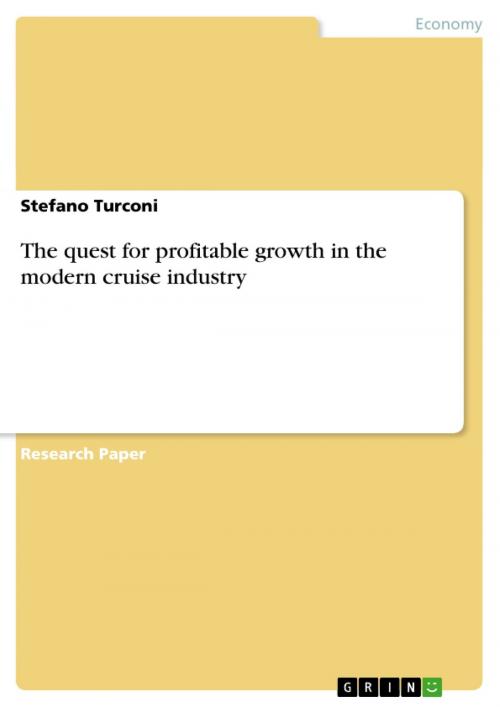The quest for profitable growth in the modern cruise industry
Business & Finance, Management & Leadership, Management| Author: | Stefano Turconi | ISBN: | 9783640812981 |
| Publisher: | GRIN Publishing | Publication: | January 28, 2011 |
| Imprint: | GRIN Publishing | Language: | English |
| Author: | Stefano Turconi |
| ISBN: | 9783640812981 |
| Publisher: | GRIN Publishing |
| Publication: | January 28, 2011 |
| Imprint: | GRIN Publishing |
| Language: | English |
Research Paper (postgraduate) from the year 2008 in the subject Business economics - Business Management, Corporate Governance, London Business School (London Business School / INSEAD), language: English, abstract: This report examines the subject of profitable growth in the modern cruise industry by comparing the financial and operating performance and the management practices of the two leading cruise operators, Carnival and Royal Caribbean, over the twelve-year period from 1996 to 2007. During the past 40 years the cruise industry has evolved from a form of mere transoceanic transportation to an alternative vacation at sea. Despite growing at a CAGR of 7.7% since 1980, the penetration rate for the cruise industry is only 17%. In North America alone the cruise industry generated $20.6 billion in 2006. By comparison, the lodging industry in North America generated revenues of $133.4 billion during the same year. The cruise industry remains a relatively young industry. This is proven by the fact that, of the 168 million passengers that have cruised globally since 1990, 72% cruised in the past ten years and 43% in the past five years alone. The cruise industry has continually expanded to meet or boost demand: 40 new ships were built in the 1980s, 80 new ships were built in the 1990s, and 46 new ships are scheduled to enter the global market within the next four years. Even though there are more than 30 brands of cruise lines, only two companies dominate this industry: Carnival Corp & Plc (CCL) and Royal Caribbean Cruises Ltd (RCL). The cruise industry remains highly segmented by product-with a variety of brands targeting a wide array of price points, consumer needs, and itineraries-but by the end of 2007 Carnival and Royal Caribbean alone controlled about two-thirds of the global capacity, with shares of 45% and 21% respectively. Back in 1987, their estimated combined share of global capacity was only 11%. Up until 2000, Carnival and Royal Caribbean followed a parallel revenue growth trajectory, though Carnival's profitability has always exceeded Royal Caribbean's. However, from 2001 onward Carnival consistently and visibly outperformed Royal Caribbean, virtually doubling in terms of global capacity share, and tripling in terms of revenues. A closer scrutiny of the two companies reveals that during the period 1996-2000 Royal Caribbean outgrew Carnival in terms of revenues 4 out of 5 years. Conversely, during the period 2001-2007, Carnival outgrew Royal Caribbean 5 out of 7 years. Most remarkable of all, Carnival achieved such astounding growth while sustaining superior profitability, as measured by its greater return on capital employed.
Research Paper (postgraduate) from the year 2008 in the subject Business economics - Business Management, Corporate Governance, London Business School (London Business School / INSEAD), language: English, abstract: This report examines the subject of profitable growth in the modern cruise industry by comparing the financial and operating performance and the management practices of the two leading cruise operators, Carnival and Royal Caribbean, over the twelve-year period from 1996 to 2007. During the past 40 years the cruise industry has evolved from a form of mere transoceanic transportation to an alternative vacation at sea. Despite growing at a CAGR of 7.7% since 1980, the penetration rate for the cruise industry is only 17%. In North America alone the cruise industry generated $20.6 billion in 2006. By comparison, the lodging industry in North America generated revenues of $133.4 billion during the same year. The cruise industry remains a relatively young industry. This is proven by the fact that, of the 168 million passengers that have cruised globally since 1990, 72% cruised in the past ten years and 43% in the past five years alone. The cruise industry has continually expanded to meet or boost demand: 40 new ships were built in the 1980s, 80 new ships were built in the 1990s, and 46 new ships are scheduled to enter the global market within the next four years. Even though there are more than 30 brands of cruise lines, only two companies dominate this industry: Carnival Corp & Plc (CCL) and Royal Caribbean Cruises Ltd (RCL). The cruise industry remains highly segmented by product-with a variety of brands targeting a wide array of price points, consumer needs, and itineraries-but by the end of 2007 Carnival and Royal Caribbean alone controlled about two-thirds of the global capacity, with shares of 45% and 21% respectively. Back in 1987, their estimated combined share of global capacity was only 11%. Up until 2000, Carnival and Royal Caribbean followed a parallel revenue growth trajectory, though Carnival's profitability has always exceeded Royal Caribbean's. However, from 2001 onward Carnival consistently and visibly outperformed Royal Caribbean, virtually doubling in terms of global capacity share, and tripling in terms of revenues. A closer scrutiny of the two companies reveals that during the period 1996-2000 Royal Caribbean outgrew Carnival in terms of revenues 4 out of 5 years. Conversely, during the period 2001-2007, Carnival outgrew Royal Caribbean 5 out of 7 years. Most remarkable of all, Carnival achieved such astounding growth while sustaining superior profitability, as measured by its greater return on capital employed.















